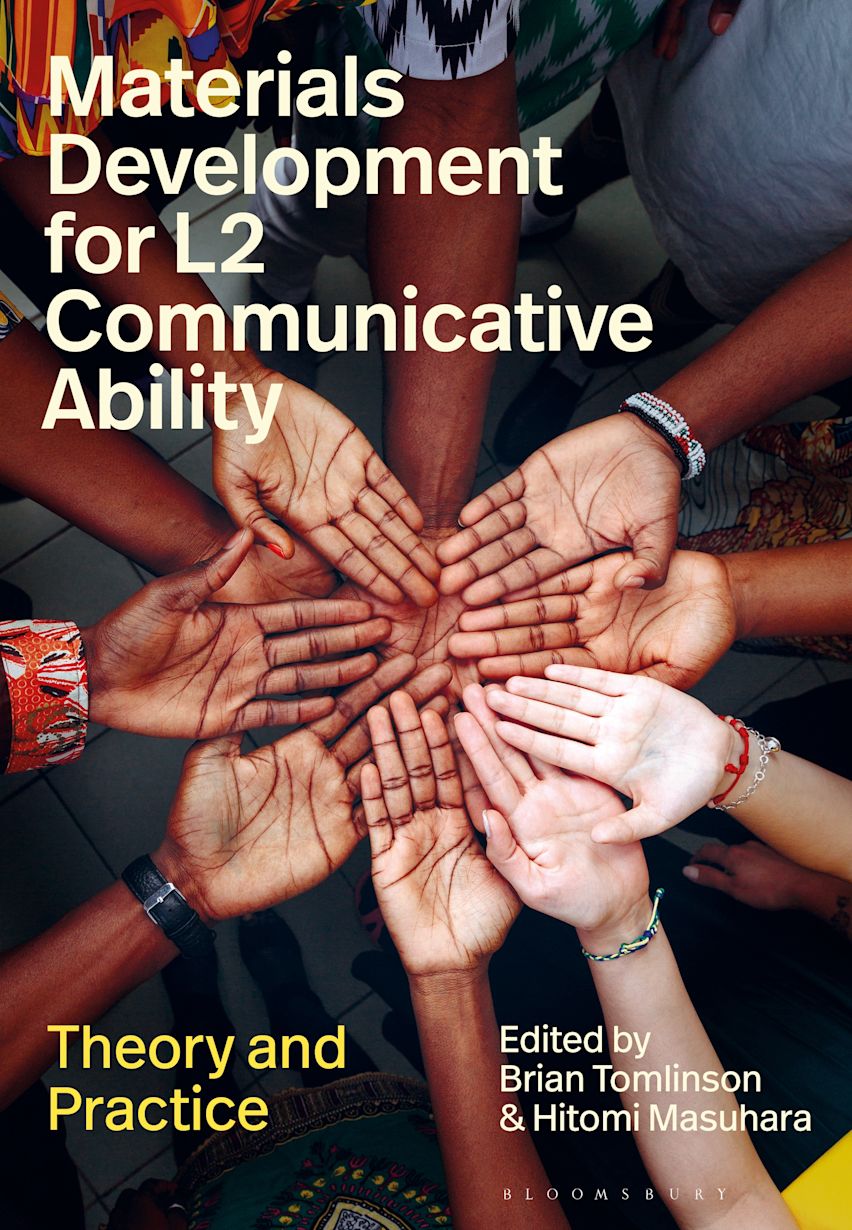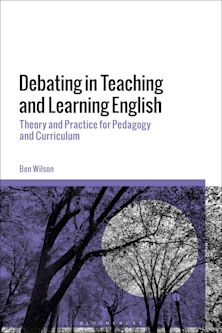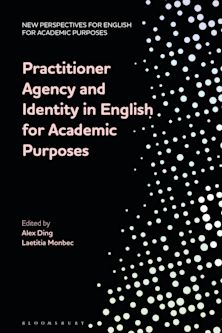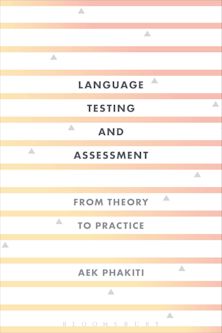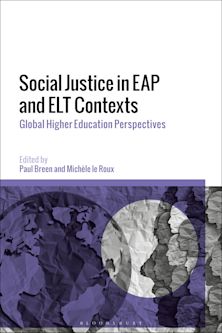Materials Development for L2 Communicative Ability
Theory and Practice
Materials Development for L2 Communicative Ability
Theory and Practice
Payment for this pre-order will be taken when the item becomes available
- Delivery and returns info
-
Free UK delivery on orders £30 or over
Description
This book has a clear and constant focus on the ultimate aim of language teaching: helping learners to develop the ability to communicate effectively. Drawn from 15 different countries, the authors discuss exactly what effective communication involves and what teachers should aim for when helping learners to develop. They then expand into the different ways in which materials can help teachers and learners to achieve this.
The chapters are organized into four sections - Proposals for Action, Materials Analysis and Evaluation, Materials Development Projects and Materials Development Research - with each section followed by comments from one of the editors on the commonalities shared by the chapters in the section and the issues that they raise. All of the chapters propose ways of developing and using materials to facilitate the development of communicative ability in any language. They are written to be accessible to newcomers in the field, and stimulating to experienced teachers, teacher trainers, materials developers and researchers.
Table of Contents
Introduction, Brian Tomlinson (Anaheim University, USA)
Part One: Proposals for Action
1. Ways of Helping Learners to Develop Communicative Ability, Brian Tomlinson (Anaheim University, University of Liverpool, MATSDA)
2. Language Teaching in a Vacuum – Communicative Adaptation and Development of Materials Needed, Hitomi Masuhara (University of Liverpool, UK)
3. Developing a Multimodal Materials Framework: Improving Engagement and Inclusivity, Jonathan White (University of Trento, Italy)
4. Making Materials Matter: A Question of Survival, Alan Maley (Freelance Educational Consultant, UK)
5. Using Interactive Activities to Enhance L2 Communication Skills, Sakae Onoda (Juntendo University, Japan)
6. 'Creating Waves': Re-defining Communication-Focused Language Teaching Goals and Paradigms, Asma Aftab (Kinnaird College for Women, Lahore, Pakistan)
7. Fostering Communicative Ability: The Role of Reflexivity and Practice-Based Research in L2 Materials Development, Anna Costantino (University of Greenwich, London, UK)
Comments on Section 1 – Brian Tomlinson (Anaheim University, University of Liverpool, MATSDA)
Part Two: Materials Analysis and Evaluation
8. Muted Material: A Critical Look at Textbook Content to Support Spoken Language Proficiency, Rúben Constantino Correia (University of Algarve, Portgual)
9. The Development of Communicative Ability in Primary EFL Coursebooks: A Comparative Study of Croatia, Portugal and Spain, Carolyn Leslie (Universidade Nova de Lisboa, Portugal), Sandie Mourão (Universidade Nova de Lisboa, Portugal), Silvija Hanžic Deda (University of Zagreb, Croatia) and José Jaime Pérez-Segura (University of Castilla-La Mancha, Spain)
10. Pre-Service Teachers as Materials Creators – Insights from a Materials Design Course, Nina Lazarevic (University of Stavanger, Norway)
11. Quiet Classrooms: "Why School Textbooks Fail to Get Us to Communicate", Karina Narymbetova (KIMEP University) and Yekaterina Rudenko (KIMEP University, Kazakhstan)
12. English Materials for Developing Communicative Ability: a Comparative Study of Children's and Adults' Coursebooks, Maria Stec (University of Silesia, Poland)
13. 'Polite talk' in the Presentation of Compliment Responses in CFL Textbooks: Problems and Solutions, Yun He (Cardiff University, UK); Chengyu Zhuang (Oxbridge AcaVice)
14. Beyond Cultural Differences: Empowering Intercultural Communication through Story Circles, Chang Liu (Newcastle University, UK)
Comments on Section 2 – Hitomi Masuhara (University of Liverpool, MATSDA)
Part Three: Materials Development Projects
15. Fostering Critical and Emotional Communication in the Language Classroom: The Collaborative Construction of a Book, Mara Regina de Almeida Griffo (Pontifical Catholic University of Rio de Janeiro, Brazil) and Adriana Nogueira Accioly Nóbrega (Pontifical Catholic University of Rio de Janeiro, Brazil)
16. Boosting Writers' Communicative Ability: The AIM Approach, Diana McCray (University of Leeds, UK), Kamola Muradkasimova (Uzbek State World Languages University, Uzbekistan) and Aziza Yunusova (Bukhara State University, Uzbekistan)
17. Developing ESP Materials for Teaching and Testing Interaction and Mediation Skills, Stephanie Ashford (Baden-Württemberg Cooperative State University (DHBW), Germany)
18. The Acquisition of Portuguese as a Foreign Language (PFL) by Chinese Students: The Role of Multimodal Translation, Castro, Catarina (ESECS / Politécnico de Leiria), Caels, Fausto (ESECS / Politécnico de Leiria) and Coelho, Flávia (ESECS / Politécnico de Leiria)
19. Designing Communication-Oriented Materials for the Teaching and Learning of Catalan as a Foreign Language: Guiding Principles, Synergies and Challenges, Ares Llop (University of Cambridge, UK) and Albert Vilagrasa (Escola Oficial d'Idiomes, Spain)
Comments on Section 3 – Brian Tomlinson (Anaheim University, University of Liverpool, MATSDA)
Part Four: Materials Development Research
20. Task-Based Language Teaching or Task-Supported Language Teaching?, Rod Ellis (Curtin University, Perth, Australia)
21. English-Immersed Conversations for Developing L2 Adult Learners' Speaking Skills, Xiaoling Jin (City University of Macau, China)
22. Designing Tasks for Language Teaching: Researching Task Sequencing and Modality, Sara Santos (University of Macau, China)
23. Humanising Multiple Choice Items in Anthrogogic Contexts, Shree Deepa (University of Hyderabad, India) and Geetha Durairajan (Formerly English and Foreign Languages University, India)
24. Pedagogical Innovation through the Co-Creation of Materials by Students and Teachers as Learners, Palmyra Baroni Nunes (SME-Rio de Janeiro, Brazil), Maria Isabel Azevedo Cunha (PUC-Rio de Janeiro, Brazil) and Inés Kayon de Miller (PUC-Rio de Janeiro, Brazil)
25. To Talk or Not to Talk? Willingness to Communicate in English as an L2: Investigating Greek and International Learners' Perspectives and Teachers' Perspectives and Strategies in Greece and Ireland, Artenisa Topouzi (University of Limerick, Ireland)
26. Creation of Communicative, Humanistic Language Learning Materials Through Optimizing Knowledge of Effective Andragogical Strategies and Teaching Tools, Catherine Moore (Anaheim University, USA)
Comments on Section 4 – Hitomi Masuhara (University of Liverpool
27. Conclusion – Brian Tomlinson and Hitomi Masuhara (University of Liverpool, UK)
Product details

| Published | 20 Aug 2026 |
|---|---|
| Format | Hardback |
| Edition | 1st |
| Extent | 496 |
| ISBN | 9781350548947 |
| Imprint | Bloomsbury Academic |
| Illustrations | 0 bw illus |
| Dimensions | 234 x 156 mm |
| Publisher | Bloomsbury Publishing |











